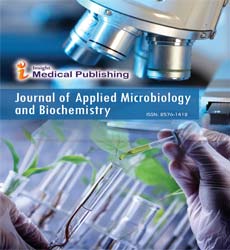ISSN : ISSN: 2576-1412
Journal of Applied Microbiology and Biochemistry
Site-Directed Mutagenesis: A Tool for Studying Enzyme Mechanisms
Kirill Shchapov*
1Department of Biology, York University, Toronto, Canada
- *Corresponding Author:
- Kirill Shchapov,
Department of Biology, York University, Toronto, Canada
E-mail: shchapov.kirill@outlook.com
Received date: November 14, 2024, Manuscript No. IPJAMB-24-20013; Editor assigned date: November 18, 2024, PreQC No. IPJAMB-24-20013 (PQ); Reviewed date: December 02, 2024, QC No. IPJAMB-24-20013; Revised date: December 09, 2024, Manuscript No. IPJAMB-24-20013 (R); Published date: December 16, 2024, DOI: 10.36648/2576-1412.8.6.258
Citation: Shchapov K (2024) Site-Directed Mutagenesis: A Tool for Studying Enzyme Mechanisms. J Appl Microbiol Biochem Vol. 8 No.6: 258.
Introduction
Enzymes, the biological catalysts essential for life, are proteins with remarkable specificity and efficiency. Understanding how enzymes function at a molecular level has extreme implications for fields such as medicine, biotechnology and fundamental biology. Site-Directed Mutagenesis (SDM), a molecular biology technique that enables targeted alterations to a gene's sequence, has become a fundamental for probing enzyme mechanisms. This article describes the principles of SDM, its role in elucidating enzyme function and the broader implications of these findings. Site-directed mutagenesis is a technique that allows researchers to introduce specific, predetermined mutations into the DNA sequence encoding a protein. The primary goal is to investigate how changes to specific amino acids impact protein structure and function, offering insights into enzyme mechanisms. The SDM process typically involves amplifying the target DNA using Polymerase Chain Reaction (PCR) with specially designed primers containing the desired mutation. Following amplification, the mutated DNA is introduced into a host organism, such as bacteria, for protein expression. This process enables researchers to analyses the effects of individual mutations. SDM can introduce various types of mutations, including Replacing one amino acid with another to test its role in catalytic activity or substrate binding. Removing specific residues to identify regions critical for function. Adding residues to test how additional elements influence the enzyme. By targeting residues in the active site or other functionally significant regions, SDM helps identify roles such as catalysis, substrate binding and allosteric regulation. For instance, altering residues near the active site can reveal their involvement in stabilizing transition states or orienting substrates for catalysis.
Probing enzyme function: Insights from mutagenesis studies
Site-directed mutagenesis has proven invaluable for unravelling the complexities of enzyme mechanisms. By systematically modifying specific residues, researchers can attribute functional roles to particular amino acids and deepen their understanding of enzyme behaviour.
The active site of an enzyme is where catalysis occurs, often involving key residues that stabilize transition states or participate directly in chemical reactions. SDM allows researchers to probe these residues' roles by substituting them with chemically similar or inert amino acids. For example, mutating a serine residue in serine proteases can confirm its role in forming the catalytic triad in need for peptide bond cleavage. SDM enables the study of substrate-enzyme interactions by altering residues in the binding pocket. By modifying residues that interact with substrates, researchers can determine how enzymes recognize and bind specific molecules. This approach has been instrumental in understanding enzymes like kinases and polymerases. Allosteric sites, distinct from the active site, allow enzymes to be regulated by molecules binding at these locations. SDM helps map these regulatory regions by disrupting or enhancing their interactions. For example, mutagenesis of regulatory domains in phosphofructokinase has elucidated how metabolic intermediates modulate enzyme activity. By mimicking natural mutations, SDM can simulate evolutionary processes, offering insights into how enzymes adapt to environmental changes or new substrates. This approach is particularly relevant in studying antibiotic resistance enzymes or designing enzymes for industrial applications.
The insights gained from site-directed mutagenesis extend beyond basic enzymology, influencing diverse fields such as drug discovery, synthetic biology and industrial biotechnology. Understanding enzyme mechanisms through SDM has paved the way for practical applications and future innovations. Many therapeutic agents target enzymes involved in disease processes. By revealing critical residues required for enzyme activity, SDM facilitates the design of inhibitors that specifically block these sites. For instance, insights from mutagenesis studies have guided the development of protease inhibitors for HIV treatment. SDM is a foundational tool in protein engineering, enabling the design of enzymes with enhanced stability, altered specificity, or improved catalytic efficiency. This has applications in creating industrial enzymes for biofuel production, pharmaceutical synthesis and environmental remediation. In synthetic biology, SDM is used to reprogram enzyme functions, creating novel metabolic pathways or biosynthetic capabilities. For example, altering enzymes in microbial systems has enabled the production of valuable compounds such as antibiotics and bioplastics. Mutations in enzymes often underlie genetic diseases. SDM helps model these mutations in vitro, providing insights into disease mechanisms and potential therapeutic interventions. For instance, studying mutations in metabolic enzymes has clarified the molecular basis of inherited disorders like phenylketonuria. Advances in genome editing technologies, such as CRISPR-Cas9 systems, have expanded the possibilities for mutagenesis.
Coupled with SDM, these tools offer unprecedented precision in studying enzyme mechanisms within cellular contexts, bridging the gap between in vitro and in vivo analyses.
Open Access Journals
- Aquaculture & Veterinary Science
- Chemistry & Chemical Sciences
- Clinical Sciences
- Engineering
- General Science
- Genetics & Molecular Biology
- Health Care & Nursing
- Immunology & Microbiology
- Materials Science
- Mathematics & Physics
- Medical Sciences
- Neurology & Psychiatry
- Oncology & Cancer Science
- Pharmaceutical Sciences
